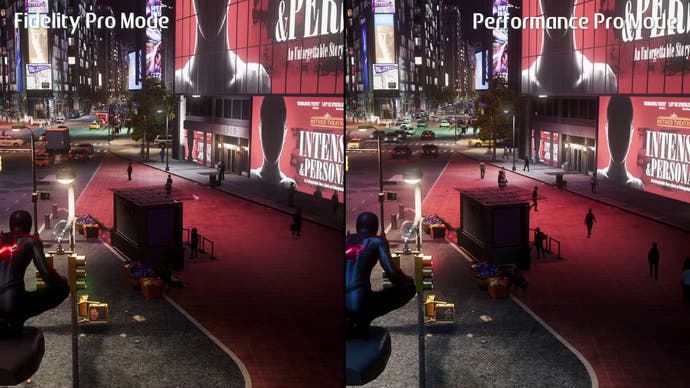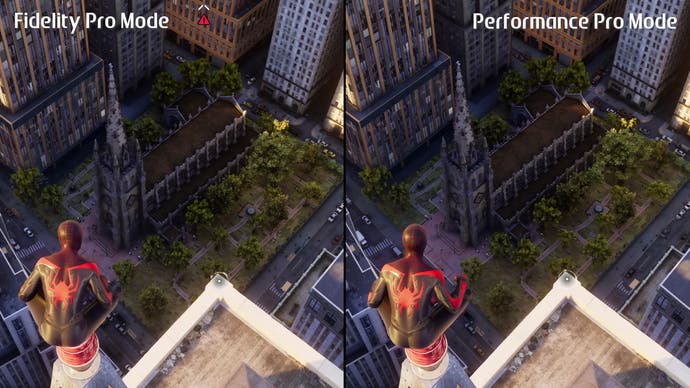Since the beginning of this generation, Insomniac Games has stood as one of Sony’s strongest internal developers. Having shipped four games on PS5 thus far, the Calfornia-based company has been busy – but despite that, the studio has constantly looked to push their tech and support new features. After all, Insomniac was one of the first to embrace 40fps output for 120Hz screens and one of the first to go all-in on ray tracing (RT) at the launch of PS5. What I didn’t expect, however, was Insomniac going back and updating every one of their PS5 titles to properly support the new PlayStation 5 Pro. That’s exactly what they’ve done, so we’re going to lay out these changes starting with their most recent release: Marvel’s Spider-Man 2.
The gist is simple – Insomniac has implemented Sony’s new PSSR upscaling feature in addition to offering additional RT options that were not available on the base system. Combine this with the various frame-rate options and you have quite a wide range of choice on the Pro, including new performance and fidelity graphics modes that work differently to the base machine.
For starters, Insomniac’s excellent temporal injection has been replaced with PSSR. The internal resolution metrics are comparable, eg with performance mode at ~1440p internally, but PSSR allows much more detail to be resolved. That also applies in the fidelity mode, which has a near-4K internal resolution and a much sharper and more stable image with PSSR onboard. However, those sitting closer to larger TVs will notice the difference more readily than those with smaller TVs and higher average viewing distances.
There are other factors here as well – these resolution numbers are for the default 30fps and 60fps modes, but if you have a 120Hz display with VRR, you gain access to additional options. As with the base PS5 version, there is a 40fps mode and uncapped options for both modes. What I’ve found is that this can influence average resolution figures slightly but, with PSSR, the difference here is less noticeable than with the base PS5. The other RT settings, when combined with the uncapped fidelity mode, can exert a slightly stronger influence on dynamic resolution, but it’s largely negligible.
I’ll get to performance numbers later but let’s first tackle this: what sort of changes exist between performance pro and fidelity pro modes? We know that additional RT features are available, but what else changes?
The answer is surprisingly comprehensive. First, elements such as draw distance, distant reflections, increased detail at proximity and additional lights are all present here. Traffic lights become more detailed at a distance, as do trees and buildings, and you can even see building reflections from across the map. The actual RT features are trickier to show off, but thankfully the game allows you to flip back and forth between the two modes without restarting the game to see how a scene changes between modes.
The first RT feature is called RT key light shadows, which refers to distant shadows cast by buildings and other large structures. Doing this at scale isn’t easy, however, but RT enables distant shadows that otherwise weren’t displayed. You can see the shadows between buildings if you look closely, and makes the world look less flat overall. If you’re using fidelity mode, I recommend enabling it.
Next up is RT reflections and interiors. There is now a ‘high’ option which essentially renders these at full resolution, ie matching the current main scene rendering resolution. This means that both reflections themselves show more detail along with the interior spaces. I still love the trick behind these interiors: they’re a series of rooms present below the map so the system can deliver proper RT results. That said, while the new high setting does make a difference, it doesn’t actually increase the detail of what’s contained within the game’s BVH structure. That means you’ll still be seeing lower-res textures and simplified objects reflected in the glass, something that you could overcome in PC versions of prior Spider-Man games but is unfortunately off-limits here.
Lastly, we have RTAO (ray-traced ambient occlusion). This is a very subtle feature, but one that adds more accurate contact shadows across the scene. This is visible from the title screen under Spider-Man’s wrist, if you want a quick comparison. The high setting also adds a screen-space GI component which is also quite subtle, but can colour buildings with the orange glow of sunset or the blue sheen of a sign for example. Again, I’d suggest using this option if you’re in the fidelity mode to push out the graphics as far as possible.


Taken together, these new features do add some nice depth to the overall presentation and fidelity mode winds up looking even better. That said it can be difficult to pinpoint these effects at a glance as the game’s art was not designed with this in mind, lessening its impact somewhat.
The bigger question is which mode is right for you? That’s where performance comes into play, with the fidelity mode capped at 30fps on a 60Hz display, with 40fps and uncapped options with a 120Hz VRR screen. The 30fps and 40fps modes both seem to lock to their respective targets, but the uncapped mode often appears to run in the 50s which works nicely with VRR. All of this is achieved with excellent image quality and all the RT features engaged. Disabling these features has a minimal impact on performance, suggesting the game is bottlenecked elsewhere in this mode.
Now, if you fancy a higher frame-rate, the performance pro mode will offer you that. RT is enabled but this is limited to the the standard RT features present in the original version of the game. It runs at a stable 60fps, but you’re also free to remove the cap on a VRR display. Our testing showed results between 60fps and 70fps, so it’s slightly improved but not by a huge margin. Therefore, my suggestion would be to use the fidelity pro mode on a 120Hz VRR display, or the performance mode if you have a 60Hz display.

As well as Spider-Man 2, Insomniac has opted to update all of their PS5 games, and there are similar options on these prior releases. Taking Ratchet and Clank: Rift Apart as an example, there are fidelity pro and performance pro modes, which work nearly identically – but the key light shadow option from Marvel’s Spider-Man 2 doesn’t make an appearance in this older game. Interestingly, performance here is also higher, with the fidelity pro mode averaging between 50fps and 60fps – an incredible result, especially with those on VRR screens to smooth out any frame-rate fluctations. The performance mode also benefits with numbers much higher on average than Spider-Man 2.
I haven’t had a chance to check out the first Spider-Man games, mind you, but I gather they use the same options as Ratchet and benefit similarly.
So the key takeaway from this is pretty simple: the new Pro-specific features are not mind-blowing, but they are certainly welcome and transform already beautiful games into something even more impressive.
More than anything though, I want these games to serve as an example to other developers when it comes to implementing user-facing technical features. These are very much mass-market games, yet Insomniac is still driven to include things such as 40fps modes or fully embracing 120Hz and VRR on top of their excellent RT work. It’s a sterling example of what a console game can be – plenty of options and all of them are good to different degrees.
fbq('init', '560747571485047');
fbq('track', 'PageView'); window.facebookPixelsDone = true;
window.dispatchEvent(new Event('BrockmanFacebookPixelsEnabled')); }
window.addEventListener('BrockmanTargetingCookiesAllowed', appendFacebookPixels);











Leave a Reply